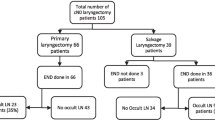Abstract
A retrospective study was done to assess the incidence and factors associated with neurological complications in patients who have undergone a functional neck dissection (FND). Four hundred forty-two epidermoid cancer patients operated on from January 1984 to December 2002 were included in the study. Clinical parameters, neurological sequelae, and other complications were evaluated in all cases. The incidence of neural damage was calculated on the nerves at risk ( n =714). Paralysis of the 11th nerve occurred in 12 cases (1.68%). A lesion of the marginal branch of the 7th cranial nerve was observed in nine cases (1.26%). Bernard-Horner’s syndrome and hypoglossal nerve paralysis were noted in four and three cases (0.56 and 0.42%), respectively. Thus, the incidence of neurological sequelae after FND is low. Neurological complications were not associated with either clinical parameters or non-neurological complications ( P >0.05). None of the factors studied can predict the appearance of neural problems in the postoperative period.
Similar content being viewed by others
References
Beahrs OH, Henson DE, Hutter RVP, Myers MH (1988) Manual for staging of Cancer. JB Lippincott, Philadelphia
Berghaus A, Holtmann S, von Scheel J, Tausch-Treml R, Herter M (1988) Preserving the accessory nerve in neck dissection. HNO 36:68–73
Blessing R, Mann W, Beck C (1986) How important is preservation of the accessory nerve in neck dissection?. Laryngol Rhinol Otol (Stuttg) 65:403–405
Bocca E, Pignataro O (1967) A conservation technique in radical neck dissection. Ann Otol Rhinol Laryngol 76:975–987
Cabra J, Herranz J, Moñux A, Gavilán J (1993) Postoperative complications of functional neck dissection. Operative techniques. Otolaryngol Head Neck Surg 4:318–321
Chepeha DB, Taylor RJ, Chepeha JC, Teknos TN, Bradford CR, Sharnna PK, Terrel JE, Wolf GT (2002) Functional assessment using Constant’s Shoulder Scale after modified radical and selective neck dissection. Head Neck 24:432–436
Dailiana ZH, Mehdian H, Gilbert A (2001). Surgical anatomy of spinal accessory nerve: is trapezius functional deficit inevitable after division of the nerve? J Hand Surg 26:137–141
Ducci M, Appetecchia M, Marzetti M (1997) Neck dissection for surgical treatment of lymph node metastasis in papillary thyroid carcinoma. J Exp Clin Cancer Res 16:333–335
El Ghani F, Van Den Breckel MW, De Goede CJ, Kuik J, Leemans CR, Smeele LE (2002) Shoulder function and patient well-being after various types of neck dissections. Clin Otolaryngol 27:403–408
Gavilán J, Gavilán C, Herranz J (1992) Functional neck dissection: three decades of controversy. Ann Otol Rhinol Laryngol 101:339–341
Leipzig B, Suen JY, English JL, Barnes J, Hooper M (1983) Functional evaluation of the spinal accessory nerve after neck dissection. Am J Surg 146:526–530
Nori S, Soo KC, Green RF, Strong EW, Miodownik S (1997) Utilization of intraoperative electroneurography to understand the innervation of the trapezius muscle. Muscle Nerve 20:279–285
Remmler D, Byers R, Scheetz J, Shell B, White G, Zimmerman S, Goepfert H (1986) A prospective study of shoulder disability resulting from radical and modified neck dissection. Head Neck Surg 8:280–286
Salerno G, Cavaliere M, Foglia A, Pellicoro DP, Mottola G, Nardone M, Galli V (2002) The 11th nerve syndrome in functional neck dissection. Laryngoscope 112:1299–1307
Shockley WW, McQueen CT, Postma GN (1995) Complications of neck surgery. In: Weissler MC, Pillsbury HC (eds) Complications of head and neck surgery. Thieme, New York, pp 122–158
Short SO, Kaplan JN, Laramore GE, Cummings CW (1984) Shoulder pain and function after neck dissection with or without preservation of the spinal accessory nerve. Am J Surg 148:478–482
Suárez O (1963) El problema de las metástasis linfáticas y alejadas del cáncer de laringe e hipofaringe. Rev Otorrinolaringol 23:83–89
Weisberger EC, Lingeman RE (1987) Cable grafting of the spinal accessory nerve for rehabilitation of shoulder function after radical neck dissection. Laryngoscope 97:915–918
Zibordi F, Baiocco F, Bascelli C, Bini A, Canepa A (1988) Spinal accessory nerve function following neck dissection. Ann Otol Rhinol Laryngol 97:83–86
Author information
Authors and Affiliations
Corresponding author
Rights and permissions
About this article
Cite this article
Prim, M.P., De Diego, J.I., Verdaguer, J.M. et al. Neurological complications following functional neck dissection. Eur Arch Otorhinolaryngol 263, 473–476 (2006). https://doi.org/10.1007/s00405-005-1028-9
Received:
Accepted:
Published:
Issue Date:
DOI: https://doi.org/10.1007/s00405-005-1028-9




